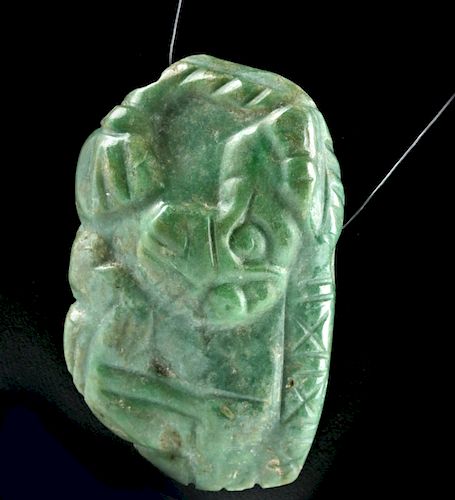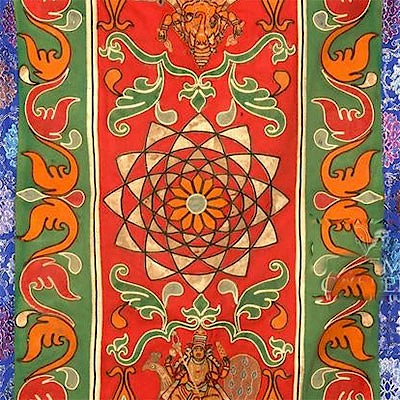Maya Carved Jade Pendant - Mythical Being
Lot 405
About Seller
Artemis Fine Arts
686 S Taylor Ave, Ste 106
Louisville, CO 80027
United States
Selling antiquities, ancient and ethnographic art online since 1993, Artemis Gallery specializes in Classical Antiquities (Egyptian, Greek, Roman, Near Eastern), Asian, Pre-Columbian, African / Tribal / Oceanographic art. Our extensive inventory includes pottery, stone, metal, wood, glass and textil...Read more
Estimate:
$2,000 - $3,000
Absentee vs Live bid
Two ways to bid:
- Leave a max absentee bid and the platform will bid on your behalf up to your maximum bid during the live auction.
- Bid live during the auction and your bids will be submitted real-time to the auctioneer.
Bid Increments
| Price | Bid Increment |
|---|---|
| $0 | $25 |
| $300 | $50 |
| $1,000 | $100 |
| $2,000 | $250 |
| $5,000 | $500 |
| $10,000 | $1,000 |
| $20,000 | $2,500 |
| $50,000 | $5,000 |
| $100,000 | $10,000 |
| $200,000 | $20,000 |
About Auction
By Artemis Fine Arts
Oct 17, 2019
Set Reminder
2019-10-17 10:00:00
2019-10-17 10:00:00
America/New_York
Bidsquare
Bidsquare : Early Fall Variety | Ancient & Ethnographic
https://www.bidsquare.com/auctions/artemis-gallery/early-fall-variety-ancient-ethnographic-4538
Discover incredible lots relisted with new, lower start prices (up to 50% less), plus many items brand-new to auction. Step back in time and around the world – you’ll be amazed at the treasures you will find. Antiquities from the Classics, Asian, Pre-Columbian African and much more! Artemis Fine Arts info@artemisgallery.com
Discover incredible lots relisted with new, lower start prices (up to 50% less), plus many items brand-new to auction. Step back in time and around the world – you’ll be amazed at the treasures you will find. Antiquities from the Classics, Asian, Pre-Columbian African and much more! Artemis Fine Arts info@artemisgallery.com
- Lot Description
**Originally Listed At $1200**
Pre-Columbian, Southern Mexico to Guatemala, Mayan Territories, Maya, Late Classic Period, ca. 550 to 900 CE. A beautiful hand-carved jade pendant of verdant green hues. The pendant is roughly ovoid in shape with a smooth verso and a carved obverse side depicting an abstract mythical figure. The head is oblong with a single circular eye, a rounded snout with thin lips, and a tall headdress, with a singular arm wrapping around the top and a hand held close to its face. A singular leg rests along the lower periphery and bears a few deeply-incised linear details. The biconically-drilled suspension holes are each situated on either side of the head, enabling the jade fragment to be worn as a stylish amulet. A fabulous example from the ancient Maya! Size: 2.375" W x 1.425" H (6 cm x 3.6 cm).
Jade was revered by the Maya not only for its beauty, but also because it had spiritual power - it was believed to be the embodiment of the wind and the "breath" that formed the Maya soul. In addition, scholars argue that its color was associated with water and vegetation. While the Maya used jade to create impressive jewelry, we also know that they placed jade beads in the mouths of the dead, perhaps as a means of extending the circle of life. Furthermore, many scholars have argued that the demand for jade contributed to the rise of long distance trading networks as well as the rise of urban centers in ancient Mesoamerica.
Provenance: private Los Angeles County, California, USA collection
All items legal to buy/sell under U.S. Statute covering cultural patrimony Code 2600, CHAPTER 14, and are guaranteed to be as described or your money back.
A Certificate of Authenticity will accompany all winning bids.
We ship worldwide and handle all shipping in-house for your convenience.
#135871Surface wear and minor abrasions commensurate with age, light fading to some carved details, with light roughness along peripheries, verso, and suspension holes, otherwise intact and excellent. Light earthen deposits within recessed areas. Motifs are still visible.Condition
- Shipping Info
-
All shipping is handled in-house for your convenience. Your invoice from Artemis Gallery will include shipping calculation instructions. If in doubt, please inquire BEFORE bidding for estimated shipping costs for individual items.
-
- Buyer's Premium



 EUR
EUR CAD
CAD AUD
AUD GBP
GBP MXN
MXN HKD
HKD CNY
CNY MYR
MYR SEK
SEK SGD
SGD CHF
CHF THB
THB














